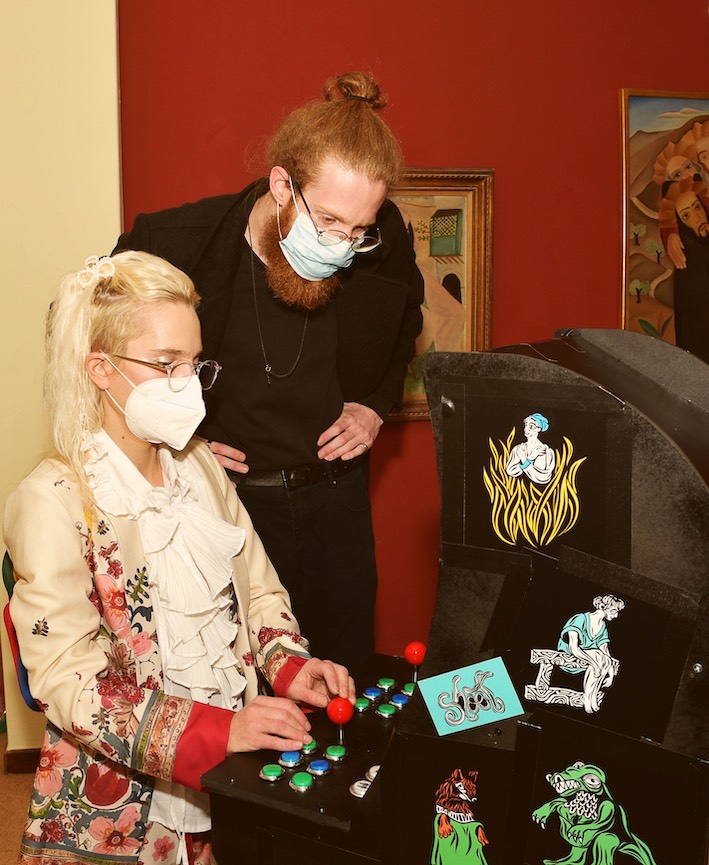“Liberation Through Hearing”, in collaboration with Shahar Sarig, is an interactive opera, based on software architecture in 2-D computer games, platform games. It is an audio-visual, large-scale work that combines a dramatic story, taking place in digital media, with game-like elements.
Like in many video games, in this saga, the user paves the way of a morphing protagonist during its journey as it encounters diverse imaginary creations. Unlike most video games, in this opera, there is no scoring, no winners or losers; one can only wander in two-dimensional space while creating the music, and the only goal is to move forward. The opera uses the architecture and the conventions of video games already cultivated in us (incorporated with actions such as shooting and jumping) to create a new kind of interactive opera.
Hand drawings constitute the main fabric of the visual aspect of the opera. In nearly all traditional 2D video games, each level or section is constructed of repetitive patterns, both musically and visually. In Liberation Through Hearing, there are no repetitions: every part is hand-drawn, and every second is composed-through. Most of the visual work is a vast painting to be crossed and interacted with while creating the music, where each level exhibits a theme following the libretto.
The opera does not aim to compete with the novelties of those ever-developing technologies. On the contrary, it adopts an old-style 2D aesthetics. Enforcing traditional methods of drawing and composition on an engine designed for repetitive patterns is a form of resistance that presents the craft and abundance of sketches and musical compositions; exhibits their infinite details. It is a celebration of the human spirit and self-expression rather than the assembly line.


Each level ends with a short non-interactive video, a cutscene (made by artist Omer Gal). In Liberation Through Hearing, they function as recitatives with a contrasting spirit to those presented in the levels. They are orchestrated for two harpsichords and a narrator (inspired by the secco recitatives) and identified by colourful, saturating, three-dimensional stop-motion films. While the levels exhibit slow, extensive movements, the recitatives present playful mashups that span from quasi-baroque or baroque music phrases to music themes from video games.
The opera’s libretto is rooted in the “Bardo Thodol”, also known as “The Tibetan Book Of The Dead”. The book is a foundational text of Tibetan Buddhism. It describes and guides one through the Bardo, a realm where the deceased’s consciousness journeys during the interval between death and the next rebirth. Vivid visualizations of after-death experiences that may culminate into hellish ordeals constitute the dramatic element from which the opera emerged.

Hearing is of great importance in Tibetan Buddhism, where the auditory cortex is the last to remain active in the human body after all other senses fail. Therefore, the deceased is guided through the Bardo through hearing. Choosing an opera to follow the spirit of the book seemed the natural option.
The opera aims to introduce the users to the dharma of the insiders, i.e., those who are devoted to seeking the truth within the nature of the mind (rather than from the outside, as in various forms of organized religion) and its teachings that include methods of freeing the individual from all limitations created by fears and misguided observations of reality.
To download Catalog, CLICK HERE
The arcade version

Live show

Liberation Through Hearing, Live @ Gaudeamus Festival, September 2023, Utrecht, The Netherlands:
Fixed media (screenshot), 2nd section and cutscene1
Fixed media (screenshot), 6th section and cutscene4
[hosted by Ubuweb]
To play the online version, choir part1:
[hosted by ScreenDive, Gaudeamus Festival]
Teaser:
The making of Liberation Through Hearing (in Hebrew):